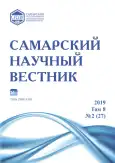Reasons for the number of insects decrease of the Samara Region (on the example of leaf beetle populations)
- Authors: Pavlov S.I.1, Yaitsky A.S.1, Miniyarov F.T.2
-
Affiliations:
- Samara State University of Social Sciences and Education
- Astrakhan State University
- Issue: Vol 8, No 2 (2019)
- Pages: 44-53
- Section: 03.02.00 – General Biology
- URL: https://journals.rcsi.science/2309-4370/article/view/34296
- DOI: https://doi.org/10.17816/snv201982108
- ID: 34296
Cite item
Full Text
Abstract
The survival mechanisms of leaf beetles (as typical phytophagous insects, surrounded by a «corrosive environment»: unstable, rapidly changing climate, «decreasing» forage, direct action of predators, ecto- and endoparasites, parasitoids, pathogens helminthiasis and entomophtorous, other pathogenic organisms) were studied during 1974-2016 in the Samara Region. 25 background species of chrysomelid beetles (approximately 240 individuals) were used as «model» objects. In addition to the natural fluctuations of the insect population, 21 causes of sudden increase in the number of local populations of leaf beetles were revealed, as a result of the influence of negative environmental agents, including abiotic (8), biotic (12) and anthropic (1 reason). From 5% to 90% of the leaf beetles population die as a result of unfavorable wintering conditions, sharp fluctuations in temperature and humidity, wind and precipitation; 2 reasons (concerning the resources of the forage base), 2 reasons (caused by the imbalance of the age and sexual structure of the population and therefore low reproductive potential), 2 reasons (determined by the fierce competition of insects and larval cannibalism) and 6 reasons (associated with the influence of predators, parasites and pathogens) are able to «withdraw» from 2% to 96% of the livestock (eggs, larvae, pupae and adults) of the population. It is concluded that many agents affects the number of insects.
Full Text
##article.viewOnOriginalSite##About the authors
Sergey Ivanovich Pavlov
Samara State University of Social Sciences and Education
Email: pavlov@pgsga.ru
candidate of biological sciences, associate professor of Biology, Ecology and Methods of Teaching Department
Russian Federation, SamaraAndrey Stepanovich Yaitsky
Samara State University of Social Sciences and Education
Email: yaitsky@pgsga.ru
senior lecturer of Chair of Biology, Ecology and Methods of Teaching
Russian Federation, SamaraFarit Talgatovich Miniyarov
Astrakhan State University
Author for correspondence.
Email: fminiyarov@mail.ru
candidate of biological sciences, associate professor of Biotechnology, Zoology and Aquaculture Department, head of Experimental Zoology Laboratory
Russian Federation, AstrakhanReferences
- Банников А.Г., Рустамов А.К. Охрана природы. Справочник. М.: Колос, 1972. С. 185-187.
- Белецкий Е.Н. Теория цикличности динамики популяций // Известия Харьковского энтомологического общества. 1993. № 1. С. 5-16.
- Stern V.M., Smith R.F. Factors affecting egg production and oviposition in populations of Colias philodice eurytheme Boisduval (Lepidoptera, Pieridae) // Hilgardia. 1960. Vol. 29, № 10. P. 411-454.
- Richards O.W., Southwood T.R.E. The abundance of insects: introduction // Insect Abundance. Oxford-Edinburgh. Blackwell Scient. Publs, 1968. P. 1-7.
- Clark D.P. A population study of Phaulacridium vittatum Sjöst (Acrididae) // Australian Journal of Zoology. 1967. Vol. 15, № 4. P. 799-672.
- Majzl O. Biomasa článkonožcov (Arthropoda) olisten korún jelše lepkavej - Almus glutinosa (L.) - so zri om na rad Coleoptera // Biologia (ČSSR). 1979. Vol. 34, № 8. P. 607-615.
- Estever A., López R.M.L., Schnack J.A. Ciclo anual, lecundidad y proporcion de sexos de una poblacion de Pelocoris (P.) binotulatus nigriculus Berg (Hemiptera, Limnocoridae) // Limnobios. 1989. Vol. 2. № 10. P. 729-732.
- Ericson D. Distribution, activity and density of some Carabidae (Coleoptera) in winter wheat fields // Pedobiologia. 1978. Vol. 18, № 3. P. 202-217.
- Garcia M.A., Paleari L.M. Ciclo de vida e potencial de crescimento populacional de Charidotis punctatostriata (Coleoptera, Chrysomelidae, Cassidinae) em laboratorio // Revista Brasileira de Entomologia. 1993. Vol. 37, № 2. P. 329-334.
- Медведев Л.Н., Рогинская Е.Я. Каталог кормовых растений жуков-листоедов СССР. М.: Наука, 1988. С. 23-44.
- Павлов С.И. Каннибализм как адекватная реакция животных на ухудшение условий обитания // Проблемы современной биологии: мат-лы 8-й междунар. науч.-практ. конф. (15.04.2013, Москва). М.: Изд-во «Спутник+», 2013. С. 51-56.
- Ковригина А.М. Биология златоглазок (Neuroptera, Chrysopidae) Среднего Поволжья // Исследования энтомофауны Среднего Поволжья: межвуз. сб. науч. ст. Куйбышев: КГПИ, 1980. С. 22-25.
- Павлов С.И. О разнице в стратегиях личинок щитоносок и их хищников // Проблемы современной биологии: мат-лы 6-й междунар. науч.-практ. конф. (15.10.2012, Москва). М.: Изд-во «Спутник+», 2012. С. 53-60.
- Hanson P.E. Biology of Janus rufiventris (Hymenoptera: Cephidae) // Annals of the Entomological Society of America. 1986. Vol. 79, № 3. P. 488-490.
- Miczulski B. Blonkowki (Hymenoptera) w biocenozie upraw rzepaku. Cz. II. Gasieniczniki (Ichneumonidae) // Polskie Pismo Entomologiczne. 1966. Ser. B, № 3-4. P. 263-292.
- Eben A., Barbercheck M.E. Field observations on host plant associations tntmies of diabroticite beetles (Chrysomelidae; Luperini) in Veracruz, Mexico // Acta Zoologica Mexicana. 1996. № 67. P. 47-65.
- Kiritani K., Hokyo N., Sasaba T., Nakasuji F. Studies on population dynamics of the green rice leafhopper, Nephotettix cinctipes Uhler: regulatory mechanism of the population density // Researches on Population Ecology. 1970. Vol. 12, № 2. P. 137-153.
- White E.G., Huffaker C.B. Regulatory processes and population cyclicity in laboratory populations of Anagasta kühniella (Zeller) (Lepidoptera: Phycitidae). 1. Competition for food and predation // Researches on Population Ecology. 1969. Vol. 11, № 1. P. 57-83.
- Полтев В.И., Гриценко И.Н., Егорова А.И., Кальвиш Т.К., Туркевич Л.Л., Ушакова Н.В. Микрофлора насекомых. Новосибирск: Наука СО, 1969. С. 109.
- Басова Л.П. Энтомофтороз зеленой яблоневой тли в Куйбышевской области // Вопросы зоологии: Ученые записки. Вып. 83. Куйбышев: КГПИ, 1970. С. 31-35.
- Басова Л.П. Энтомофторовые грибы - паразиты насекомых в Куйбышевской области // Материалы итоговой научной конф. Март 1970. Биолого-химический ф-т. Куйбышев: КГПИ, 1970. С. 18-19.
- Приставко В.П. К познанию микрофлоры личинок колорадского жука Leptinotarsa decemlineata Say. (Coleoptera, Chrysomelidae) // Энтомол. обозрение. 1966. Т. 45, № 2. С. 302-312.
- Приставко В.П. Изменение микрофлоры и рН гемолимфы личинок колорадского жука под влиянием гриба белой мускардины (Beauveria bassiana (Bals.) Vuill.) и ДДТ // Защита растений: респ. межвед. темат. науч. сб. Вып. 4. Киев: Урожай, 1967. С. 47-59.
Supplementary files









